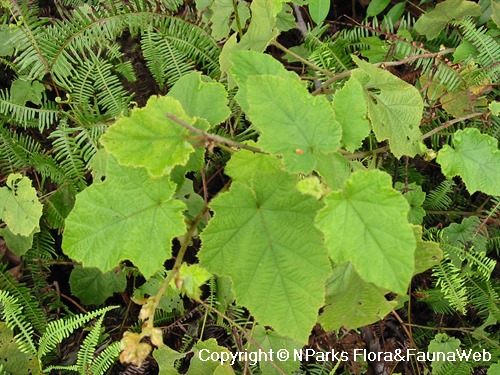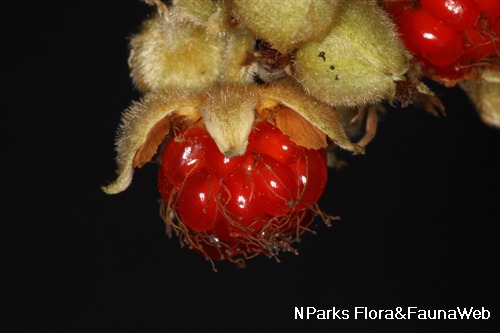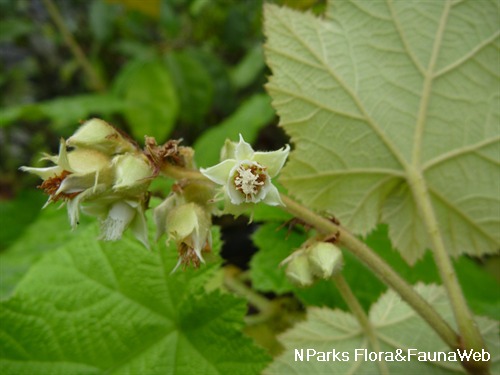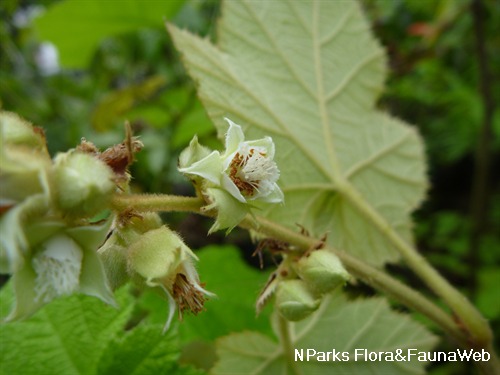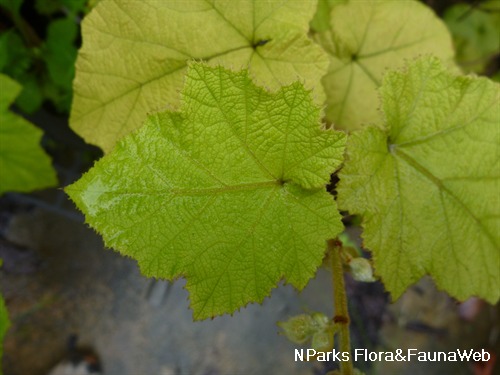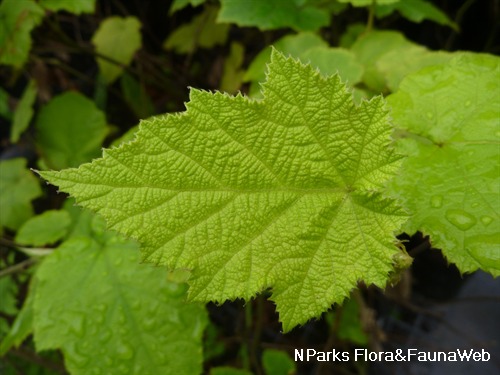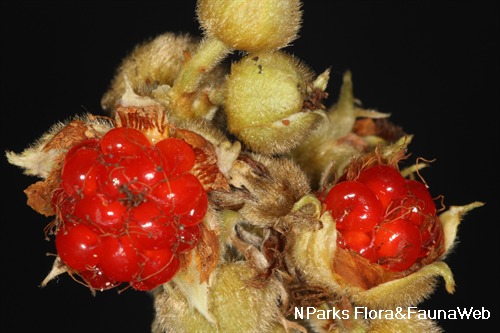
Back
Rubus moluccanus var. angulosus Kalkman
| Family Name: | Rosaceae |
| Common Name: | Tempu Rengat, Broad-Leaf Bramble, Malayan bramble, Akar kupur, Duri berumbet |
Name
Classifications and Characteristics
| Plant Division | Angiosperms (Flowering Seed Plants) (Dicotyledon) |
|---|---|
| Plant Growth Form | Shrub, Climber |
| Lifespan (in Singapore) | Perennial |
| Mode of Nutrition | Autotrophic |
| Plant Shape | Irregular |
Biogeography
| Native Distribution | Andaman and Nicobar Islands, Vietnam, Thailand, Sumatra and adjacent islands, Peninsular Malaysia, Singapore, the Philippines, Borneo, Java, Sulawesi, and the Lesser Sunda Islands |
|---|---|
| Native Habitat | Terrestrial (Primary Rainforest, Secondary Rainforest, Coastal Forest, Freshwater Swamp Forest, Disturbed Area / Open Ground) |
| Preferred Climate Zone | Tropical |
| Local Conservation Status | Native to Singapore (Vulnerable (VU)) |
Description and Ethnobotany
| Growth Form | It is a prickly shrub, or climber with stem up to 10 m long. |
|---|---|
| Foliage | Its alternate, long-stalked leaves have finely toothed leaf blades that are egg-shaped to broadly egg-shaped, 3–7 lobed, and 6–20 by 4–18 cm, with thin, curly hairs on their undersides. |
| Stems | Stems are covered with prickles. |
| Flowers | Its branched, flowering shoots are up to 50 cm long, and consist of up to 30 white flowers that usually crowded at the end. |
| Fruit | Its fleshy fruits are rounded, red when ripe, and 2–3 by 1–2 mm when dry. |
| Habitat | It grows along forest edges, in secondary forests and thickets, near the beach, and on riverbanks, up to 1,000 m altitude. It occurs locally in Nee Soon Swamp Forest, and Temenggong Road. |
| Associated Fauna | Its flowers are insect-pollinated. It is the preferred local food plant for caterpillars of the moth, Phyllonorycter penangensi. Its red fruits are eaten and dispersed by birds and terrestrial mammals too. |
| Cultivation | It can be propagated by seed, or stem cuttings. |
| Etymology | Latin Rubus means blackberry, bramble, and raspberry; Latin moluccanus, of the Moluccas, from which the type species originated; Latin angulosus, many angled, referring to the many lobes of the leaf blades. |
| Ethnobotanical Uses | Edible Plant Parts : Edible Fruits Medicinal: The roots are boiled and taken as medicine for dysentery. Others: This species has horticultural potential as an ornamental climber for its distinctive leaves, and attractive, orange-red fruits. |
Landscaping Features
| Landscaping | This climber may be suitable for gardens or parks as a barrier plant because of the numerous prickles on the stem. Its leaves and orange-red fruits are attractive and distinctive. It is also hardy and can grow over a wide range of habitats from coastal to inland sites, from wet to dry soil conditions. |
|---|---|
| Desirable Plant Features | Ornamental Foliage, Ornamental Fruits |
| Landscape Uses | General, Parks & Gardens, Small Gardens, Coastal |
Plant Care and Propagation
| Light Preference | Full Sun |
|---|---|
| Water Preference | Moderate Water |
| Rootzone Tolerance | Moist Soils, Well-Drained Soils |
Foliar
| Foliage Retention | Evergreen |
|---|---|
| Mature Foliage Colour(s) | Green |
| Foliar Type | Simple / Unifoliate |
| Foliar Arrangement Along Stem | Alternate |
| Foliar Attachment to Stem | Petiolate |
| Foliar Shape(s) | Non-Palm Foliage (Elliptical, Palmate, Cordate) |
| Foliar Venation | Pinnate / Net |
| Foliar Margin | Denticulate |
| Foliar Base | Cordate |
| Leaf Area Index (LAI) for Green Plot Ratio | 4.5 (Shrub & Groundcover - Dicot) |
Floral (Angiosperm)
| Flower Colour(s) | White |
|---|
Fruit, Seed and Spore
| Mature Fruit Colour(s) | Red |
|---|
References
| References | Ang, W. F., A. F. S. L. Lok, K. Y. Chong, B. Y. Q. Ng, S. M. Suen & H. T. W. Tan. 2010. The distribution and status in Singapore of Rubus moluccanus L. var. angulosus Kalkman (Rosaceae). Nature in Singapore. 3. 91-97 |
|---|
Image Repository
Others
| Master ID | 1103 |
|---|---|
| Species ID | 2396 |
| Flora Disclaimer | The information in this website has been compiled from reliable sources, such as reference works on medicinal plants. It is not a substitute for medical advice or treatment and NParks does not purport to provide any medical advice. Readers should always consult his/her physician before using or consuming a plant for medicinal purposes. |

